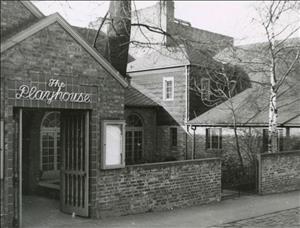On February 2, 1930, the Seattle Repertory Playhouse inaugurates its new home at 4045 University Way with a production of George Bernard Shaw’s Major Barbara. The theater will remain a major center for the dramatic arts -- and leftwing politics -- until it is taken over by the University of Washington in 1950.
The “Old Rep” (not to be confused with the Seattle Repertory Theatre) was founded in 1928 by Burton W. James (1888-1951) and his wife, Florence Bean James (1892-1988), former drama instructors at the Cornish School. Florence James served as producing director; her husband was the company’s leading actor and stage craftsman. They were soon joined by Albert Ottenheimer, a 1927 graduate of the University of Washington whose many duties would include press agent, playwright, director, and actor, performing in more than 150 roles.
The Repertory performed for two seasons in makeshift venues -- first at the Metropolitan Theater (where the Olympic Hotel now stands) and then at the Women’s Century Club (now occupied by the Harvard Exit). The end of the second season coincided with the 1929 stock market crash and the beginning of the Great Depression. Nonetheless, the Jameses went ahead with plans to purchase a brick storehouse at 41st Avenue NE and University Way and turn it into a permanent home for a company that had grown to include about 15 members.
The Curtain Rises
Arthur Loveless, a leading Seattle architect, drew up the plans to transform the storehouse (originally a tile factory) into “a rambling, all-brick playhouse graced with an airy arcade that looked out over a tree-shaded, flagstone courtyard” (Skreen, 10). Mark Tobey, a former colleague of the Jameses at Cornish, designed the acting mask mosaic that greeted theatergoers in the entryway. The theater has since undergone two major renovations (most recently in 2009) and the courtyard and its signature elm are gone, but the mosaic remain.
Opening night in the new Playhouse was delayed a week due to construction, and the curtain was held for an hour because of last-minute electrical work. “The opening night was a nightmare,” Burton James wrote in a letter to Glenn Hughes, continuing: “a poor audience, the show-me kind, and all of us dog tired and it was just rotten. Twice I had to ask for lines and the good Lord knows I’ve never had to do that before…” (quoted in Bennett, 33). (Hughes, soon to become head of the drama department at the University of Washington, was then vice president of the Repertory’s board of directors; he and the Jameses later became bitter rivals.)
With opening night behind them, the cast improved and attendance increased. The financial situation, however, remained tenuous. Apart from subsistence pay for Ottenheimer and the Jameses, only one stagehand received any sort of salary for several years. Louise Hastert Pennock, an early leading lady at the Playhouse, remembered that at her first audition, “Pop -- we all called Mr. James by that name -- wasn’t too interested in my previous training. What he really wanted to know was: ‘Do you have the means to support yourself?’" (Skreen, 10).
By 1932, the Jameses had fallen behind on their payments to the owner of the building. They were forced to issue a quit claim, losing their down payment and giving up any legal interest in the building. They were able to lease it back under generous terms (15 percent of the gross on all revenues) but they were never able to buy it.
Stage Left?
During the next two decades, the Repertory Playhouse built a reputation as a progressive and inclusive community theater. The playbills included the full range of classical and modern theater, including works that were controversial at the time, such as Clifford Odet's pro-labor Waiting for Lefty. “Rather than cater to the presumed escapist entertainment preferences of the businessmen and wives who made up their theater-party audiences, the Repertory’s directors exhibited considerable independence in the plays they produced,” a Seattle Times critic concluded (Skreen, 10).
The theater also lent its facilities to leftwing organizations such as The Church of the People, led by the Reverend Fred Shorter, and provided a venue for such “radical” causes as the Washington State Pension Union and the Group Health Cooperative.
In 1948, the Playhouse’s founders were targeted by the Washington State Legislative Committee on Un-American Activities, headed by Rep. Albert Canwell. Audiences dwindled, advance sales plummeted, and profits vanished. Florence James recalled that former friends turned their faces away and crossed the street to avoid meeting her. In 1950, with the Playhouse near bankruptcy, the property owner was pressured to sell the building to the University’s School of Drama.
The final curtain for the Seattle Repertory Playhouse fell on December 30, 1950. Fittingly, the last season ended with a production of Pygmalion, by George Bernard Show, whose Major Barbara had opened the Playhouse 20 years earlier.
The theater, which has continued to serve as a home for UW drama productions, was closed in June 2007 for an extensive renovation, its first in 40 years. The old brick building was gutted and the roof raised to provide a second story. It was reopened in February 2009 as the Floyd and Delores Jones Playhouse Theater. Floyd Jones, a 1954 graduate of the UW, donated $2 million of the $11 million cost of the renovation in memory of his wife, Delores. The large elm that had graced the courtyard could not be salvaged. Its wood was used to make benches for the new, larger lobby. Mark Tobey’s mosaic remains in its original place of honor.

